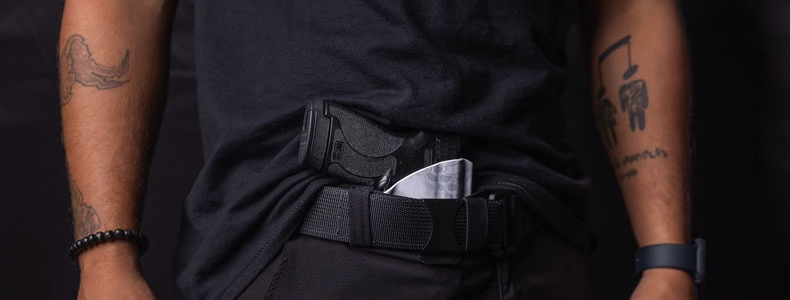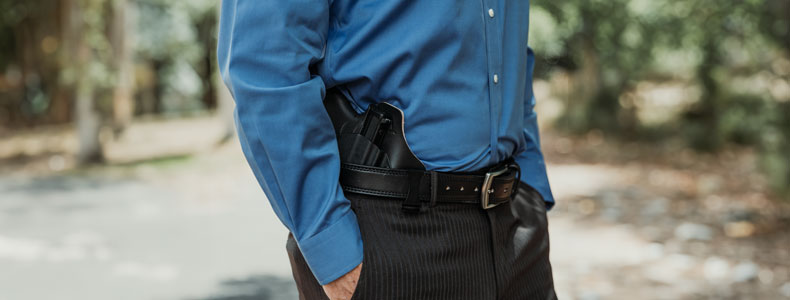Glock 42 vs 43: What is the Difference?

If you’re considering a Glock for concealed carry, you are probably wondering what the difference is between the Glock 42 and Glock 43. After all, they are only a number off, right?
Aside from the obvious differences in caliber and size, there are a few other things you’ll want to take into consideration when choosing between the Glock 42 vs 43. From differences in recoil to optics and triggers, you might be surprised by how different these two Glocks really are.
We won’t keep you waiting any longer. Read on to learn about the differences and similarities between the Glock 42 vs 43.
Products Mentioned In This Article
Glock 42

If you love Glock and want the smallest one possible, look no further than the Glock 42. With its ultra-compact dimensions and ease of shooting, this tiny but mighty gun quickly gained popularity in the concealed carry world.
Chambered in .380 Auto, this striker-fired gun is built with a black polymer frame and Tenifer-coated ordinance-grade steel slide. Like most Glocks, the 42 uses the Safe-Action trigger system that Glock owners have come to love. The Glock 42 may come standard with a 6-round magazine, though extended magazines are available if you are looking for a higher capacity.
At less than an inch wide, the Glock 42 is one of the smallest Glocks available on the market, making it great for deep concealment. Looking for a Glock 42 holster? Check out our array of Kydex and hybrid holsters here.
Glock 43

As with many Glock models, the 43 is known for its concealability and accuracy, not to mention its customizability, which makes it great for shooters of all hand sizes.
Built with a standard black polymer frame, this striker-fired pistol uses a Tenifer-coated ordinance-grade steel slide. When it comes to safety, the Glock 43 uses Glock’s Safe-Action trigger system and is chambered in 9mm Luger. While this pistol comes standard with a 6-round magazine, extended magazine options are available if you are looking for a higher capacity.
The popular Glock 43 has the features people love about the larger framed Glocks in a smaller, more compact size. If you want to check out holsters for the Glock 43, check out our selection here.
Glock 42 vs Glock 43 Specs
Glock 42 vs 43: Size & Capacity
At first glance, there’s no arguing that the Glock 42 is the smaller of the two guns. But how different are they, really?
The Glock 42 is 4.13” tall, 5.94” long, and 0.98” wide, with a barrel length of 3.24” and a weight of 13.76 ounces. The Glock 43 comes in at just over 4 ounces heavier than the 42, weighing 17.99 ounces. The 43 stands 4.25”, 6.26” long, and 1.06” wide, with a barrel length of 3.41”.
Looking at capacity, these two tiny but mighty pistols are identical. They both come standard with a 6-round magazine, though extended magazines are available if you want to increase the capacity.
Glock 42 vs 43: Ergonomics
Frame
The frames of the Glock 42 and Glock 43 are nearly identical. They both are built with a black polymer frame and built-in beaver tail design for a high and tight grip.
It’s worth noting that neither of these guns is modular, meaning you won’t be able to change out the backstraps, but that’s not uncommon for guns of this size.
Slide & Barrel
Both the Glock 42 and Glock 43 feature a Tenifer-coated ordinance-grade steel slide. While the slide material and function are the same for these two pistols, the Glock 43’s slide is slightly bigger. Ultimately, that means you might find it easier to grab than the 42.
When it comes to recoil, the 43 will typically have a bit more recoil simply because of the difference in caliber. But both of these guns are very shootable, even for those people who are sensitive to recoil.
Glock 42 vs 43: Sights & Optics
You won’t find anything special about the sights on these two guns. Both the Glock 42 and Glock 43 come standard with Glock’s plastic sights. Don’t fret, though, as both models can be easily upgraded to the sights of your choice.
While the Glock 42 does not come in an optics-ready variation, the Glock 43X MOS is a recent release and can be fitted with a red dot sight.

Glock 42 vs 43: Controls
Safety
While neither the Glock 42 or Glock 43 features a manual safety, they both come equipped with the Safe Action System. This system consists of three independent mechanical safeties that disengage as the trigger is pulled and re-engage as it is released. The Safe Action System does provide protection if the firearm is dropped.
Trigger
You might think the trigger on these two guns would be the same since they are the same generation (Gen4), but the 43’s trigger is slightly different. Compared to the trigger of the 42, the Glock 43’s trigger has a heavy and stiff break with short resent. The 42, on the other hand, has a light take-up with more of a rolling break.
Which is Right for Me?

Ultimately, what works best for you depends on your needs. You can’t go wrong with either option for home defense or concealed carry.
When comparing the Glock 42 vs 43, you will find the obvious differences like size and caliber, along with some smaller distinctions. If you are looking for the smallest Glock pistol, look no further than the 42. Its ultra-compact size makes it a great option for deep concealment. However, if you have your sights set on a 9mm, the Glock 43 may be the right choice for you. Still compact, it’s an excellent option for concealed carry.
If you’re looking for belts or holsters for the Glock 42 or 43, we recommend visiting our Holsters by Gun Model page. For all of our belt and holster options and for more information to help you choose the carry system that works best for you, visit our Vedder Holsters website.
Looking for items beyond holsters and belts? Check out our Resources Page for popular product links like lights, lasers, first aid, maintenance, and more.




